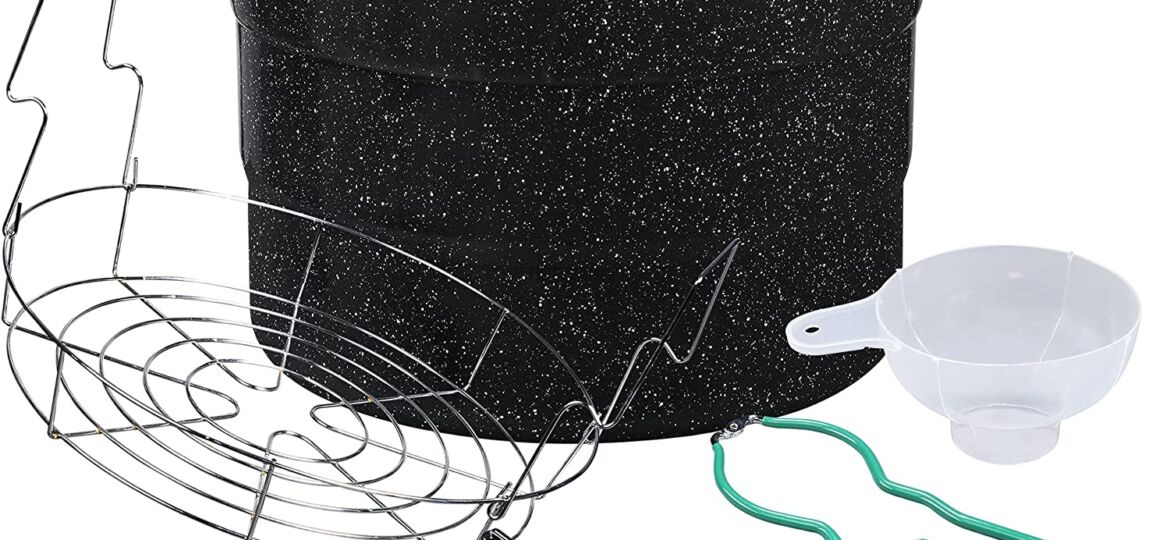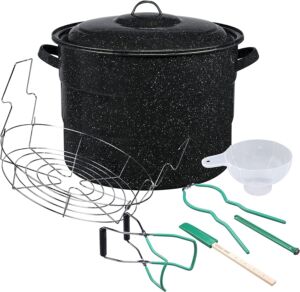
If you have your own vegetable garden, you know how it goes. It’s either feast or famine! Canning is a perfect way to preserve excess fruits and vegetables. You can use it to make straight canned produce or to preserve things like chutneys, relishes, and jellies. If you want to start canning your own produce, the first thing you’ll need is the right canning pot. Picking out a canning pot can be a little confusing if you’re new to home canning. Fortunately, it’s not that complicated once you know what to look for. Keep reading as we walk you through how to choose the best canning pot for your needs.
Water Bath Canning
The first thing you need to know is there are two main canning techniques. Water bath canning and pressure canning.
Here are the basic steps involved in water bath canning:
- Fill your jars with pre-cooked food
- Seal loosely
- Cover with water and boil in a large pot for the time stated in the recipe you’re using
Water bath canning is only suitable for high-acid foods and recipes like:
- Jellies
- Jams
- Preserves
- Marmalades
- Fruit spreads
- Fruit sauces
- Pickles
- Relishes
- Chutneys
- Tomatoes
Water bath canning doesn’t require a lot of specialized equipment, which is why it’s often the method beginners try first.
Choosing the Best Water Bath Canning Pot
For water bath canning, you need will need a large stock pot. You will also need a wire rack to keep your jars raised off the bottom of the pot. This allows the water to circulate evenly and distribute heat into the jars. We’d also recommend you pick up a pair of canning tongs so you can easily remove your jars from the pot. If you already have a large stock pot, you could save yourself some money and just purchase a wire canning rack for under $20. If you do need to invest in a new pot to do your water bath canning, we’d recommend choosing a water bath canning pot over a regular stock pot. Water bath canning pots aren’t very different from regular stock pots, and they can easily double as a stock pot for boiling and blanching.The main difference is that a canning pot will come with the right size wire rack and have the right dimensions for canning jars. Here are a few other considerations to think about.
Size
How big do you want to go with your canning pot? The most common size is 21 quarts. A 21-quart pot is the ideal size for holding 7 single-quart jars. This size pot is a good choice if you want to can in quart jars but don’t have storage space for a super-sized pot.If storage space is at a premium and you only want to can small amounts at a time, you can opt for a small 11.5-quart bath canner. This will hold 7-pint jars. If you’re looking to can large amounts of produce, our pick would be a jumbo 33-quart canner.
Pro tip: Unless storage space is your top priority, go bigger than you think when picking out a pot. Canning is a lot like regenerative vegetable gardening. The more you get into it, the more you want to produce.
Stove Compatibility
Before you lay out money on a boiling water canner, think about what kind of stovetop you have. If you have an electric range, pick a pot with a smooth bottom. This will allow for even heat distribution. For gas burners, you can use either flat or ridged-bottom pots.
Material
Most canning pots are either aluminum, stainless steel, or enamel coated. Enamel-coated pots are great for heat absorption and distribution and are pretty inexpensive. But, they are prone to chipping over time. They’re also not ideal for ceramic or smooth glass electric ranges. Aluminum pots don’t chip or rust, but they are susceptible to denting, especially if the metal is thin. The best canning pots are usually made of stainless steel. Stainless steel canning pots won’t rust, chip, or dent, making them a worthy investment for the homesteader who’s planning on doing a lot of canning.
Water bath canning pot suggestions
The Granite Ware Water Bath Canning Pot is a great option.
- CANNER KIT/SET INCLUDES: 21.5-Quart Water Bath canner with lid and rack & 5-Piece Tool Set.
- EASY TO HANDLE JAR RACK: Includes rust-proof chromed steel rack that holds 7 1-Quart jars,9 pint jars & 12 one-half pint jars; jars not included.
- 5-PIECE TOOL SET INCLUDES: Bubble remover & ruler, jar lifter, magnetic lid lifter, jar wrench & jar funnel.
- EVENLY DISTRIBUTES HEAT: Porcelain surface with durable steel core provides excellent heat distribution, reducing heat up time and saving energy.
- USE & CARE: Water-bath Canner diswasher safe, rack & tool set hand wash, NOT recommended for glass cooktops.
Pressure Cooker Canning
A lot of people are afraid of pressure cookers, but they can be invaluable for canning.
With a pressure canner, you’ll be able to can low-acid foods that aren’t safe to do with a boiling water canner.
These include:
- Vegetables
- Meat
- Poultry
Another benefit of pressure canning is that you don’t have to cook the food first. Instead, you can do what’s known as cold canning and simply pack your jars with the raw ingredients.
This can save a lot of time, hassle, and kitchen cleanup.
With a pressure canner, you also don’t have to pre-sterilize your jars.
Pressure canners allow you to obtain temperatures that even the best canning pot can’t deliver. Heat and pressure are a fail-safe microbe-killing combo, which is why pressure canning is so versatile.
What to Look For in a Pressure Canner
If you want a pressure canner, the most important thing to look for is a pressure gauge. This is the main thing that differentiates a pressure canner from a regular pressure cooker. Without a pressure gauge, you won’t be able to guarantee sterilization.
Size
Once again, size is a key consideration. If you see yourself as a long-term homesteader, we’d definitely recommend sizing up with a 23-quart pressure canner.
Multi-Function
If you don’t already own a stovetop pressure cooker, we’d recommend getting a pressure canner/cooker combo that can do double duty in your kitchen. Do not apply this tip to electric pressure canners. Pressure cookers that advertise themselves as multi-functional—able to do everything from canning to yogurt making—might not be safe to can with.
Heat Source
Another thing to think about is the heat source. Do you want to do your canning on the stovetop, or would you prefer an electric pressure canner you can plug in at the wall?If you opt for an electric pressure canner, and you’re feeling intimidated by canning—you can also choose a sensor-operated model. These often double as boiling water canners and have in-built canning programs. The sensors can also automatically adjust for pressure canning at high altitudes.
Brand
What brand to buy is another big consideration. All American is a trusted brand that has been making pressure canners for decades. Presto is another reliable brand. Miro is a good budget choice.
Steam Canners
Steam canners have become pretty popular over the last few years. They are deemed safe for preserving food, but like water bath canners, you can only use them for high-acid foods with a pH of 4.6 or less. The main benefits of steam canners are that they use less water and require less time to heat up. On the downside, steam canners are single-use items that can’t double up as a stock pot.
Go Forth and Preserve Your Harvest
Canning is a time-honored way to preserve one’s harvest. If you want to start canning in earnest, we’d recommend a pressure canner, as it’s more versatile and convenient. If you just want to can fruit and other acidic foods once in a while, a water bath canner could be a more useful choice. Now that you know how to pick out the best canning pot for your needs, all that’s left is to get canning. Looking for more tips, tricks, and canning pot how-to’s? Head to our food storage page.


